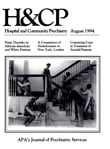Characteristics of African-American and White Patients With Panic Disorder and Agoraphobia
Abstract
Objective: The authors explored the clinical characteristics and treatment response of African-American and white patients with panic disorder and agoraphobia who presented for treatment at an anxiety disorders clinic.
Methods: One hundred white and 43 African-American patients were evaluated using a structured interview and completed a variety of standardized rating scales. In addition, data regarding clinical characteristics, psychiatric history, childhood history, life stressors, and treatment outcome were obtained by chart review. The incidence of isolated sleep paralysis was also assessed in a subsample of patients.
Results: The two groups had no significant differences in psychiatric symptoms. African-American patients were more likely to use a medical emergency room, to have had childhood separations, and to have bad parents who abused substances. They also reported less separation anxiety, school phobia, and affective illness in family members. In addition, African Americans, both patients and nonclinical control subjects, were more likely to report that they experienced repetitive episodes of isolated sleep paralysis. Treatment outcome was moderately successful among both African-American patients and white patients.
Conclusions: Although African-American and white patients show similar symptoms of panic disorder, African-American patients had more unnecessary psychiatric hospitalizations, a higher rate of medical emergency room visits, a higher incidence of isolated sleep paralysis, greater likelihood of childhood trauma, and a greater number of life stressors. Addressing these issues in treatment is critical in reducing the dropout rate and maintaining successful treatment.
Access content
To read the fulltext, please use one of the options below to sign in or purchase access.- Personal login
- Institutional Login
- Sign in via OpenAthens
- Register for access
-
Please login/register if you wish to pair your device and check access availability.
Not a subscriber?
PsychiatryOnline subscription options offer access to the DSM-5 library, books, journals, CME, and patient resources. This all-in-one virtual library provides psychiatrists and mental health professionals with key resources for diagnosis, treatment, research, and professional development.
Need more help? PsychiatryOnline Customer Service may be reached by emailing [email protected] or by calling 800-368-5777 (in the U.S.) or 703-907-7322 (outside the U.S.).



